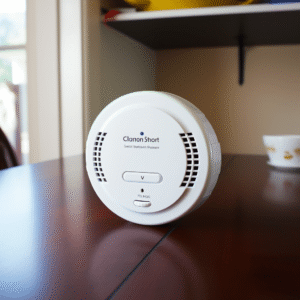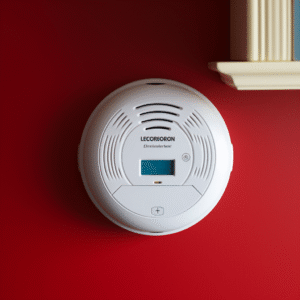Alternative gases can cause a carbon monoxide alarm to go off. These include Isopropyl alcohol, acetylene, sulfur dioxide, hydrogen sulfide, ethylene, propane, mercaptan, dimethyl sulfide, hydrogen cyanide, ethyl alcohol, methyl alcohol and nitrogen dioxide. It is all because the detector is an electrochemical sensor.
Carbon monoxide (CO) is an unseen dangerous gas that is odorless, colorless, and tasteless. It formulates when fuels such as wood, charcoal, coal, gasoline, kerosene, natural gas, and propane don’t entirely burn or when they are exposed to fire.
In the U.S., due to carbon monoxide’s vital health risks, most states have made carbon monoxide detectors mandatory in homes. The CO is referred to as a silent killer because there is no way you can detect its presence in your home, thus making carbon monoxide alarms handy.
Table of Contents
Carbon Monoxide Detectors in the Home

These are devices made to detect the presence of carbon monoxide in the house as you cannot smell the gas. That is why it is significant to install the device, as it can detect the gas’s presence and give you an alert for your safety.
The detectors are structured to alert their user anytime it detects a gas. Therefore if it rings continuously in the middle of the night, there is a valid reason for that.
Many complain about the carbon monoxide detectors ringing continuously in the middle of the night for no reason? But how sure are you of this claim? Well, as we unveil the answer to these questions and more tips on the topic.
Other Gases that Can Set Off a Carbon Monoxide Detector
Carbon monoxide detectors are electrochemical sensors that sense any carbon monoxide gas leaks. In addition, they also detect other gases in the house, which can trigger and set off the detector alarm.
Here is a list of the other gases that can set off carbon monoxide detectors:
- Nitrogen peroxide
- Hydrogen cyanide
- Ethylene
- Methyl alcohol
- Ethyl alcohol
- Mercaptan
- Dimethyl sulfide
- Propane
- Sulfur dioxide
- Acetylene, and
- Isopropyl alcohol
Therefore, firefighters should look out for these other gases after ruling out the presence of a carbon dioxide gas leak in the house whose owner called for the CO leak. For the time being, don’t rush to contact the fire department team; ensure your home is not susceptible to other gases.
Many appliances are sources of carbon monoxide, so CO levels can shoot very fast if any of them are not well maintained, fail to work correctly, and are in an area that lacks proper ventilation.
It is essential not to disregard the warnings from the devices, saying there is no reason for them not being produced to set off for no reason. If you fail to figure out why then it is best to contact the fire department.
Nonetheless, it is vital not to stay indoors when the detector goes off for safety purposes. Switch off any appliance that formulates carbon monoxide immediately, and quickly open the windows to enable sufficient ventilation inside the house, then go out and call the fire department.
How Can You Prevent Other Gases from Setting Off the CO Detector?
For effective control of the other gases setting off your carbon monoxide detector, make sure to:
Purchase a Modern Carbon Monoxide Detector
The recently manufactured detector alarms contain more features and are more effective at detecting carbon monoxide gas, except for the other gases in the house and its surroundings.
Replace the device
If you have used your detector for more than 10 years, it is prime time to change it with a new one. Check your detector’s battery level. To avoid malfunctioning issues, always check on your alarm’s battery’s level to curb misbehaving, such as going off anyhow, even in the odd hour of the night when the temperatures are low.
Please acquire a carbon monoxide detector with a separate battery for easy replacement when it becomes low rather than changing the complete detector device.
Check for Loose Wire or Nuts
Tighten loose screws or nuts, put back any flexible wire in the detector, and see whether the problem resolves.
Why Is Carbon Detector Ringing and Meaning?
The detector consists of various beep patterns to pass a message, whether an emergency or a faulty one. Therefore, it is crucial to understand the difference between the chirps by constantly referring to the alarm’s specific model manual.
4 beeps and a pause: It indicates that there is carbon monoxide carbon present in the air, and you should seek fresh air away from the scene and call 9-1-1
1 beep every minute: It is a sign that your battery levels are low and need a replacement.
5 beeps every time: it is a clear sign that your detector has hit its lifespan mark. Therefore it is time to replace it with a new one.
How to Check Your Detector for Proper Functionality

Check the carbon monoxide detectors monthly to ensure they discharge their duties effectively. To test the alarms, press and hold the test button on the detector device, producing 4 beeps for 5-6 seconds.
If the alarm fails to test adequately, change the batteries and ensure they are correctly installed. Additionally, ensure the device alarm is clean and free of dust, then retest again, and if the improper test persists, replace the whole CO detector on the spot.
Carbon monoxide alarms are the perfect way to tell if carbon monoxide is in the air and notify you of the presence of the poisonous gas. While it can be harmless in an open or well-ventilated space, it can be lethal in enclosed spaces.
It is impossible to detect the presence of CO because of its odorless smell posing significant health risks and even death. It is paramount to install detectors and, more so, understand how they work, the difference in their beeps, and what they indicate.
That way, you will know whether other gases trigger the setting off as we have discussed above or it is the carbon that is present in the air, or it may be that the battery levels have gone down, and finally, whether it has reached the prime of its life and a replacement.
Never dismiss the warning claiming there is no valid reason. Obey the alarm for your safety.


